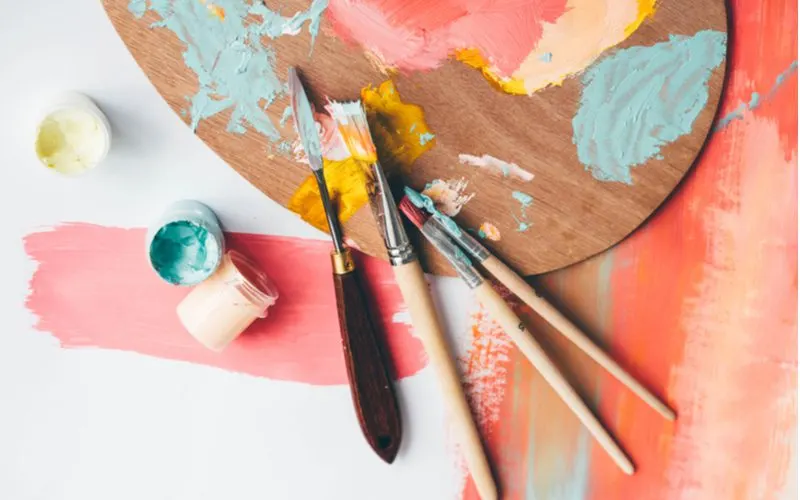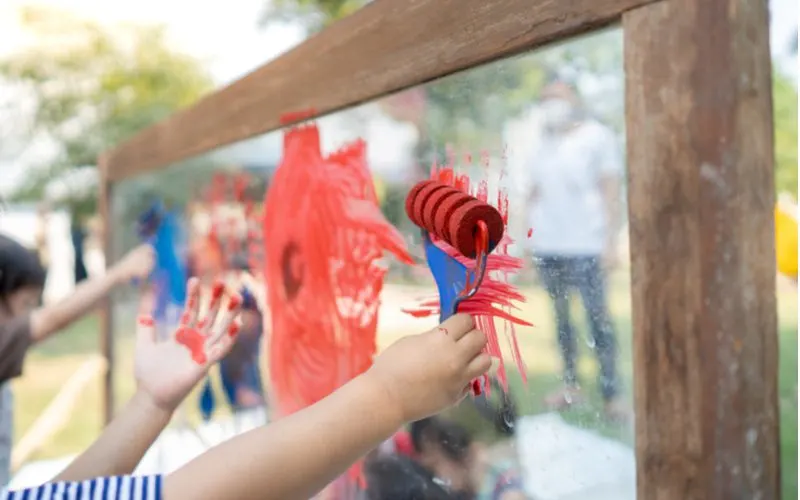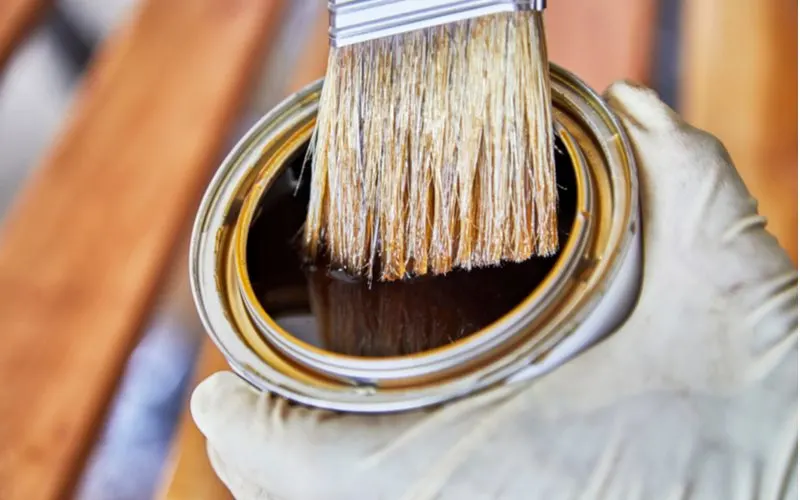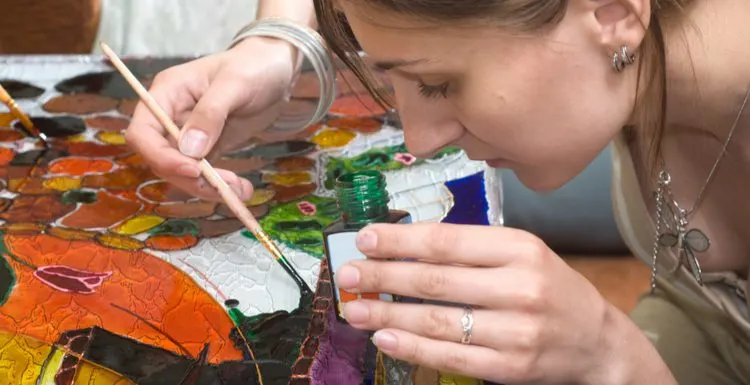Can you paint glass? If so, what steps should you take?
If you’re asking either of these questions, you’re in the right place. We’ve done the research to make a step-by-step guide to show you exactly how to do it.
Can You Paint Glass?
You can paint glass using acrylic enamel and paints specially formulated for use on glass. All types of glass are suitable for painting, including jars, vases, windows, and block tiles.
While you can easily paint glass, you need to choose the right type of paint. Some types of paint don’t stick to smooth glass surfaces.
Here’s what you should know to successfully paint glass.
How to Paint Glass in 5 Steps
Painting glass isn’t too difficult. Here are the steps involved:
- Buy paint and supplies
- Clean the glass
- Prepare your work area
- Paint your glass
- Apply a finishing coat
Keep in mind that the steps may vary slightly depending on what you’re painting. Adding a decorative painting to a glass vase isn’t the same as covering a basement window with paint to block sunlight.
1. Buy Paint and Supplies

Mariia Korneeva/Shutterstock
The first step is to obtain paint and supplies for painting glass. The items you’re likely to need for this project include:
- Paintbrushes or rollers
- Paint tray
- Paint and primer
- Clear acrylic finish
- Rags
- Disposable latex gloves
- Soap or glass cleaner
- Tape, plastic sheets, or tarps
Some of these materials are optional. For example, if you’re painting glass jars, you may not need large plastic tarps to protect surrounding surfaces or appliances.
However, if you’re painting glass tile blocks in the basement windows, you may want to tape the area around the windows and lay plastic sheets to protect the floor.
The primer is also optional. If you’re adding decorative elements to glass, you can simply paint directly on the glass. Primer is useful for covering a large area, so you can use fewer coats of paint. Brushes, rollers, and other applicator tools are needed to paint the glass.
The tools that you use depend on the look you want to achieve. Small brushes, toothpicks, and cotton swabs are useful for small details. Applicator sponges and cotton balls can also be used to add different shapes or textures.
What Type of Paint Should You Use?
Latex-based paints and oil-based paints may not adhere to the smooth surface of glass objects. Acrylic-based paints dry quickly and are more likely to stick to the glass.
The top paints for painting glass include:
- Acrylic enamel paint
- Acrylic glass paint
- Solvent-based paints
Acrylic glass paint is specifically designed for use on glass and tile surfaces. The paint includes chemical additives that help it stick to the non-porous surface of glass objects. Solvent-based paints are oil-based paints.
They are harder to clean up and don’t stick to the glass easily. However, if you apply light layers, you can achieve brighter, more saturated colors.
Glass painting markers are also available and a good choice if completing this project with kids. The markers come in various sizes and colors but may not offer long-lasting results.
The colors are likely to fade and chip over time. Overall, acrylic enamel is the safest and easiest option. It’s readily available and comes in a wide range of colors. The paint dries fast and forms a hard shell that keeps it from peeling or sliding off the glass.
If you’re painting a large surface, such as a window, consider buying spray paint or using a spray gun. If you’re painting smaller objects or painting detailed images, you can use individual bottles of acrylic paint or solvent-based paint.
2. Clean the Glass

Olena Yakobchuk/Shutterstock
Thoroughly clean the glass that you want to paint. Dirt, debris, and grease may result in bumps or inconsistent brushstrokes when painting.
Use hot water and soap to clean the glass. You may need to use an abrasive scrubbing pad to remove stubborn debris or labels. After cleaning the glass, allow it to air dry.
Avoid touching the area that you want to paint. Wear a disposable latex glove when handling the glass to avoid smudging it with your fingers.
Oil and dirt from your hands keep the paint from sticking to the glass, which may lead to bubbles and other blemishes in the paint job.
3. Prepare Your Work Area

Steve Cukrov/Shutterstock
Prepare the area where you plan on painting. If you can handle the object, such as a glass jar, you’ll likely want to paint on a table. Lay several layers of newspaper or a sheet of cardboard to protect the table from paint.
If you’re painting a fixed object, such as a glass window or tile, protect the surrounding area using painter’s tape and plastic sheets.
If you’re using solvent-based paint or acrylic glass paint, ensure that the room is properly ventilated.
These paints may release volatile organic chemicals (VOCs) that could lead to respiratory issues. Turn on a fan, open doors and windows, and wear a protective mask.
4. Paint Your Glass

Tienuskin/Shutterstock
After cleaning the glass and preparing your work area, start painting. A primer is only necessary when painting a large surface. In most cases, you can simply start painting with a brush or a roller.
If you’re trying to achieve a stained-glass look, you may only want one or two coats. If you want to block light, you’ll likely need multiple coats. After a single coat, you may notice that light still penetrates the glass.
Using stencils may help when adding decorative paintings to glass. You can tape the stencil to the glass and paint the visible area inside the cutout.
If you’re using more than one color, wait for the first one to dry before using a second one. Even if the colors don’t touch, you may accidentally smear portions of the glass that haven’t dried.
You can also trace images. If you can reach both sides of the glass object, tape the image that you want to recreate to the opposite side of the glass. You can see the image through the glass as you paint. Touching up the paint job is also easy.
If you need to remove paint, wait for the paint to dry before chipping it away with a toothpick. After you finish painting, you can remove any protective material, such as tape or plastic sheets.
5. Apply a Finishing Coat

Pamela Au/Shutterstock
Applying a finish helps protect your paint job from scratches and general wear. Without a finish, the paint can easily be wiped off the glass using a rag with hot water.
Use a clear acrylic enamel finish, which is available in bottles and spray cans. Acrylic topcoats come in a variety of finishes, including matte, flat, semi-gloss, and glossy. Use a glossy finish to make the surface shiny or a matte finish for a glare-free look.
You should also check the instructions on the acrylic paint that you used for your paint job. Some paint products require heat to fully cure.
You need to place the glassware in the oven. If the paint requires heating to fully cure, you don’t need to add a separate finish.
Keep in mind that your newly painted glassware isn’t likely to be considered food-safe or dishwasher-safe. Painting glass is mostly used for decorative purposes, craft projects, or blocking sunlight.
So, Can You Paint Glass?
So, can you paint glass? The short answer is yes; you can.
Use acrylic enamel paint to paint glass surfaces, including windows, jars, and tiles. If you plan on covering a large glass surface with paint, you may want to apply primer first.
Adding a finishing coat is also recommended to protect the paint job from scratches.

